Logical reasoning test is one of the most popular aptitude tests used in pre-employment assessment. Through this test, candidates can show their potential problem-solving and critical thinking ability – in other words, show employers that they are the best fit for the position. Therefore, you should prepare carefully for this aptitude test to ensure you are an outstanding candidate for your desired position.
This article will give you an overview on logical reasoning tests, including the definition, question types, typical test providers, and common tips and tricks to pass this test.
Table of Contents
What is a logical reasoning test?
Logical reasoning test is an assessment tool used by employers to evaluate a candidate’s ability to form concrete sequential thinking to reach a conclusion based on the inference of the given information. There are 2 main question types of Logical Reasoning test: deductive reasoning question and inductive reasoning question. A test may only include one type or mix both test types at once.
- Deductive reasoning question: Requires you to form a particular conclusion from the given information (premises) and relations of the subjects.
- Inductive reasoning question: Requires you to observe and figure out the relations of the subject to form a general conclusion.

The passing score of this test varies based on test providers and companies, but an average passing score is 70% for most logical reasoning tests. However, recruiters only notice the best performers for a position. Therefore, a good score for Logical Reasoning test is 80%.
Logical reasoning test – Deductive reasoning question
A deductive reasoning question assesses a candidate’s capacity to draw a conclusion by examining and interpreting the general facts and relations, and show one’s potential analytical thinking and fact-based decision-making. There are three main types of deductive reasoning questions:
- Syllogism question: Identify whether a collection of premises may result in the conclusions presented.
- Ordering and arrangement question: Organize subjects in the proper order based on given conditions.
- Grouping question: Interpret the conditions to select, distribute or categorize the subjects into groups.
Compared to inductive reasoning questions, deductive reasoning questions are not as prevalent. Some popular test providers that include deductive reasoning questions are:
- SHL
- Kenexa
- Talogy CUBIKs
Read more:
What is a Deductive Reasoning Test?
How to Pass Deductive Reasoning Tests?
Two steps to solve deductive reasoning questions
Step 1. Make a diagrammatic logic model from the question
You should carry out these actions for this step
1. Knowing the different sorts of inquiries can help you choose the best strategy.
2. Determine the subjects and the set of guidelines that govern how they interact.
3. Each premise (or condition) should be individually interpreted into its corresponding logic model (s). DO NOT TRY TO SOLVE ALL PREMISES/CONDITIONS AT THE SAME TIME. You should investigate each query and determine its logic model since each condition/premise has a separate logic model.
Step 2. Interpret the diagram to identify the subjects’ relationship.
Using the similar logic that you use to build the diagram, you can now examine each choice of the questions, following these actions:
1. Identify the subjects to be examined in the diagram.
2. Look at their position on the diagram and name the correspondent relationship to them.
3. Cross-check with the choice given in the question to determine whether it is true or false.
Example of deductive reasoning question
Question
Statements:
All tables are phones
Some phones are gadgets
Conclusion: Some gadgets are not tables.
Does this conclusion follow or not follow?
Answer
Denote:
~ Ta: Tables
~ Ph: Phones
~ Ga: Gadgets
Step 1
All tables are phones ⇒ Ta ⊂ Ph
Some phones are gadgets ⇒ Ph ∩ Ga
Using Euler circle, we have the following diagram:

Step 2
Some gadgets are not tables.
If one is Tables, then it must be Phones (Ta ⊂ Ph)
If one is Phones, then it can be Gadgets (Ph ∩ Ga)
⇒ If one is Gadgets, it can be Tables.
⇒ Some Gadgets can be Tables.
⇒ Data is insufficient to deduce that: Some gadgets are not tables.
Therefore, CONCLUSION DOES NOT FOLLOW.
Logical reasoning test – Inductive reasoning question
Inductive reasoning question (or abstract reasoning) is a question type that asks you to identify and interpret patterns between the subjects and choose the correct pattern for those subjects.
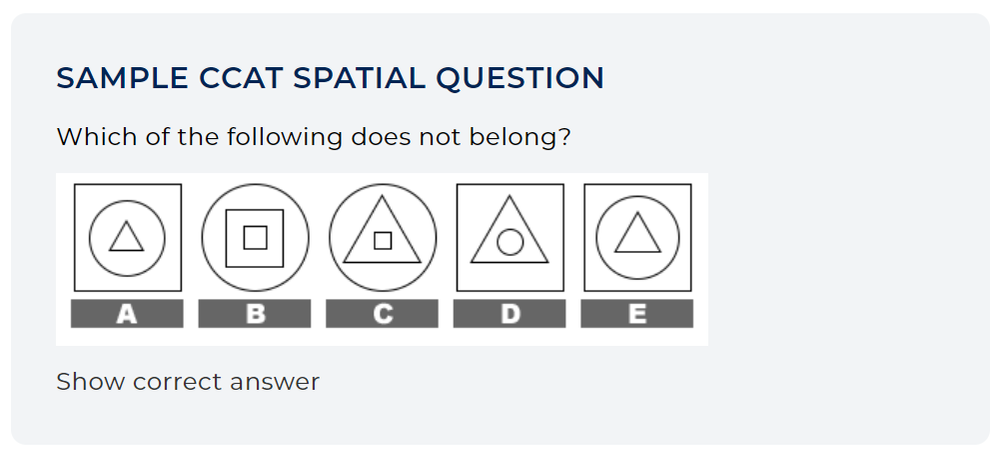
Inductive reasoning question – Criterion CCAT
Most test providers use this type of question to assess the test takers’ logical reasoning ability. The common test providers with this kind of question in their aptitude test are:
- SHL
- Saville
- Kenexa
- Aon
- Talent Q
- Talogy CUBIKS
- Test Partnership
- Criterion CCAT
- Wonderlic
- Sova
Three key tips for Inductive reasoning questions
Learn the most common patterns
In the inductive reasoning test, there are some common patterns frequently used by test makers. The trick for you is to familiarize yourself with as many types of patterns as possible. These include:
- rotation
- mirroring
- flipping
- replacement
- swapping
- side/shapes changing (division, multiplication, addition, subtraction)
- trends (constant, increasing, decreasing). etc.
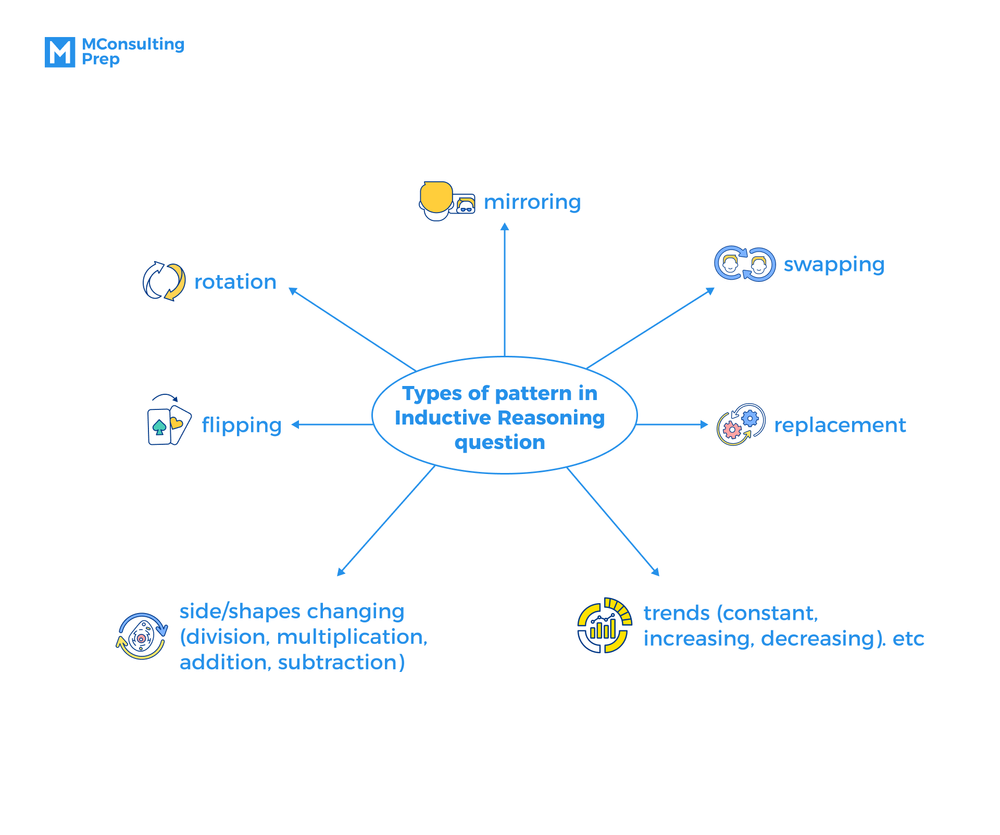
Use the elimination method
In the elimination method, you can rule out one answer option at a time until only one is left, so it must be the correct answer. This could work under the circumstances that you are confused between two answers or having a hard time figuring out the pattern.
Only look at one aspect of a shape (or one sub-pattern) at a time
Within any logical reasoning question, there will normally be numerous objects that have their distinct patterns. You should focus on figuring out the pattern of one object at a time, following it through to the end, and eliminating any answer options that don’t fit.
Example of inductive reasoning question
Question
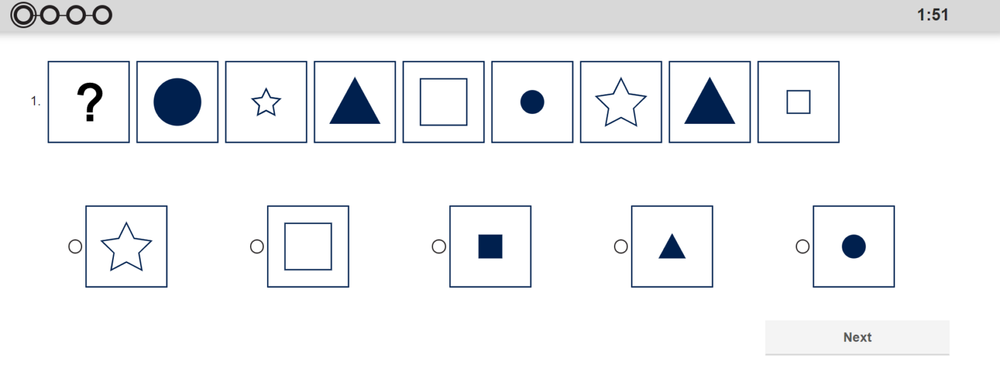
Source: Saville
Answer
There are three patterns in the sequence: size pattern, shape pattern, and color pattern
- Color pattern: goes from black to white to black then so on
- Shape pattern: the pattern “square – circle – star – triangle” is repeated
- Size pattern: the pattern is “two consecutive big size shapes – one small size shape”
The shape after the question mark is a big black circle, then followed by a small white star. Therefore, based on the three pattern rules, the answer must be the big white square.
Which test providers have logical reasoning tests?
SHL
In a typical SHL logical (inductive) reasoning test, the candidate will go through 18 questions and have 24 minutes to complete all the questions. This gives candidates approximately 80 seconds for each inductive reasoning question.
The format of the question is pattern sequence – with two different version, including Standard Multiple-choice and Interactive Verify.
- Standard Multiple-choice

Source: SHL Test
- Interactive Verify: This is the gamified version of the traditional test. Instead of choosing suitable match from the given answers, test takers will need to come up with the answer themselves and color the suitable pattern.
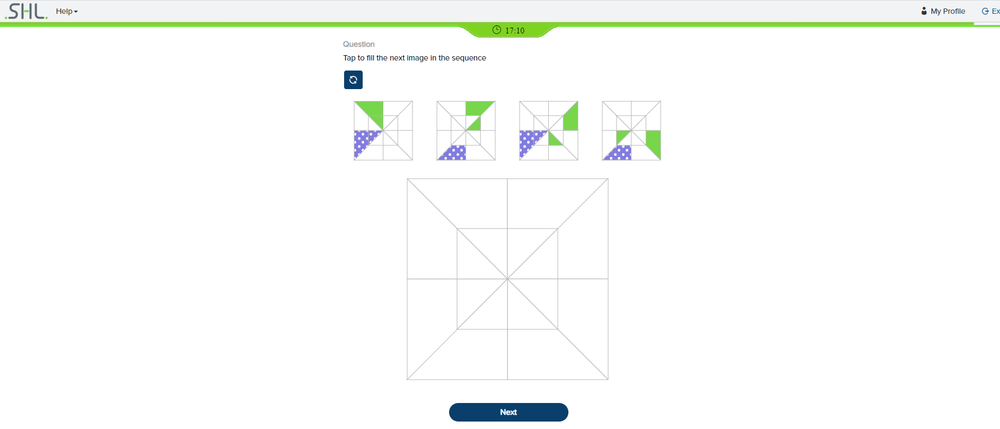
Source: SHL Test
Talent Q
Talent Q’s Elements Logical Test, created by Korn Ferry, contains questions in the form of diagrammatic reasoning.
Typically, a Talent Q assessment allows for 15 minutes to complete 12 questions. This gives you only 75 seconds for each question. In addition, there are 7 or 14 possible answers to choose in the question. This creates a challenge to the applicants in terms of time pressure and accuracy.
Here is an example of a logical reasoning question from TalentQ test:

Source: Talent Q
AON (Cut-e)
AON assessment test for abstract logical reasoning consists of unlimited number of questions; the candidates’ goal is to finish as many questions with accuracy as possible. There are three types of test in AON Logical Reasoning Assessment: Switch Challege, Gap Challege and Scales ix. The latter two types are similar to inductive reasoning questions
- Scales ix: The test presents 10 objects with an underlying pattern rule. Test takers need to choose the odd object that does not follow the rule.

Source: AON Assessment
- Gap Challenge: You are presented with a 4*4 or 5*5 grid with a set of shapes. Your task is to figure out what shape would go in this square with “?” mark. This game has similar rule to Sudoku game – no shape is repeated in any row or column.
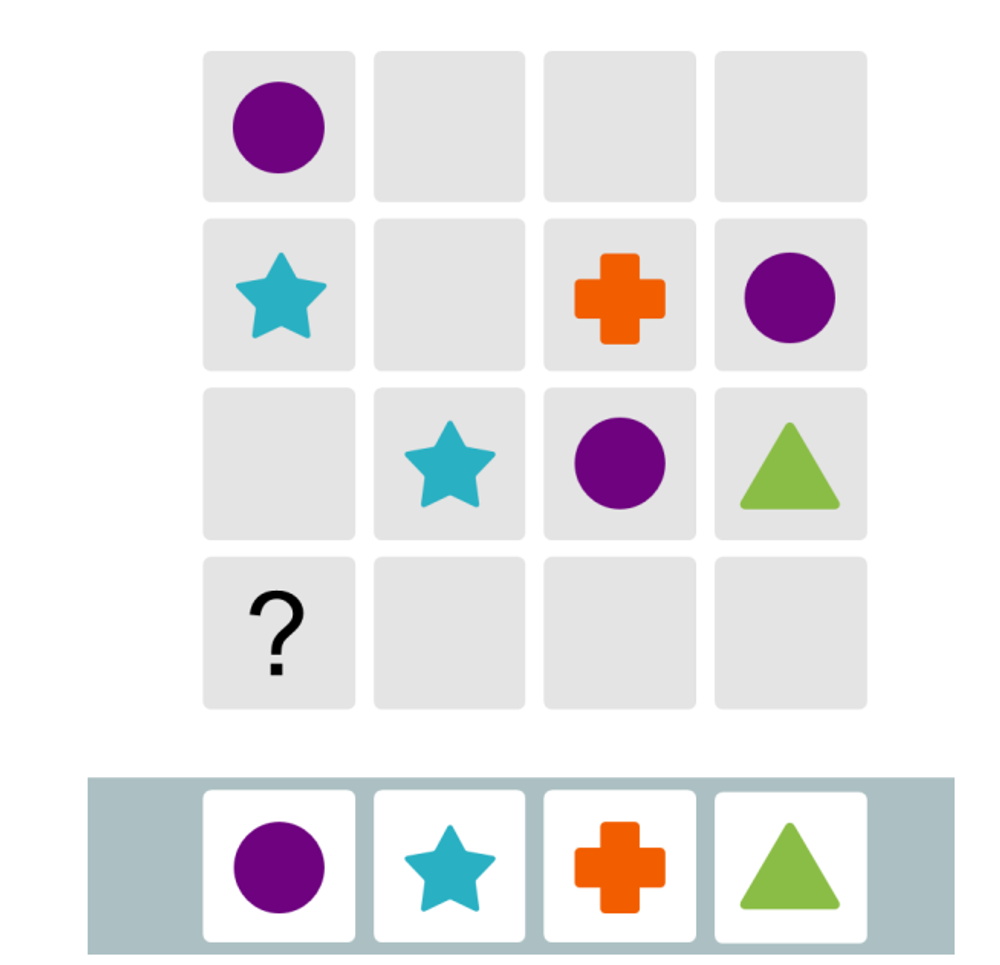
Source: AON Assessment
Test Partnership
Test Partnership inductive reasoning test contains 15 questions within 15 minutes. Test taker have one minute to finish each question and can not go back if they pass a question. Therefore, one need to answer each question fast with accuracy.
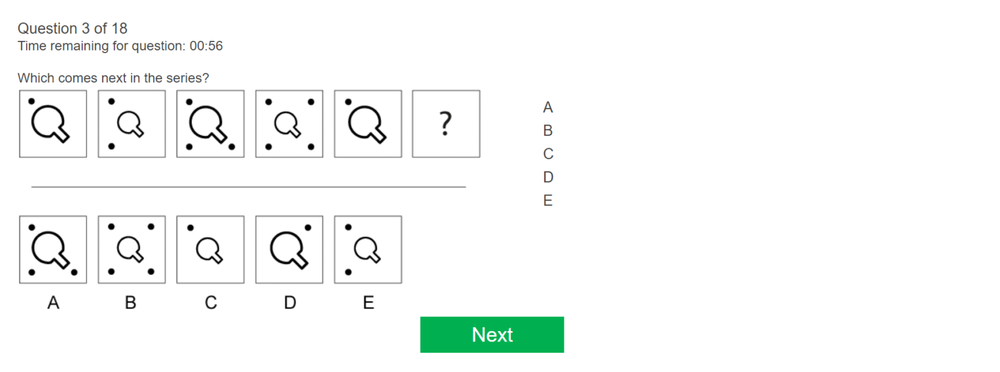
Source: Test Partnership
Common mistakes while taking the logical reasoning test
Solve too many inputs at once
In the real test, you may find yourself trying to put every piece of information together to solve the problems – jumping from clues to clues, from one pattern to another.
There are two things you should put in mind:
- One-by-one: While solving a question, choose only one aspect or element to work on.
- Step-by-step: Don’t try to find a shortcut, just move from one aspect to another aspect to make sure you don’t make any false assumption. In addtion, each question has different strategies; therefore, you should prepare strategies to approach each question type to be more confident in the real test.
Do not pay attention to accuracy
Accuracy is the top key to get to the passing score or the high percentile of the test. You need to work on each question carefully and practice with different types of logical reasoning questions
Forget about the timing
Timing is a common reason why a candidate can not finish the Logical Reasoning test. It could be really challenging since you only have 60-90 seconds for each question (the test usually has nearly 20 questions with a time limit of around 15 minutes).
Practicing with the timed mock test is the best way to control your pace while taking the test, as well as stimulate yourself under the pressure of the real test.
Our Deductive Reasoning Package could prepare you for your upcoming Logical Reasoning Aptitude Test, with excellent strategies to approach each question type included in our Guide Book. The Package comes with over 250 questions of different types, and time count in practice tests to simulate the real test.
/filters:quality(75)//case_thumb/public/1699589977462_aptitude_tests_package_4_x.png)